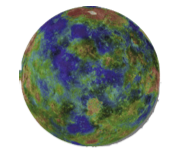Background
The multi-world perspective of statistical inference
| Planet name | Appearance | Description |
|---|---|---|
| Earth |  |
The planet that we care about, the place about which we want to be able to draw conclusions. |
| Sample |  |
Planet Sample is populated entirely with the cases we have collected on Planet Earth. As such, it somewhat resembles Earth, but many of the details are missing, perhaps even whole countries or continents or seas. And of course, it is much smaller than Planet Earth. |
| Null |  |
Planet Null is a boring planet. Nothing is happening there. Express it how you will: All groups all have the same mean values. The model coefficients are zero. Different variables are unrelated to one another. Dullsville. But even if it’s dull, it’s not a polished billiard ball that looks the same from every perspective. It’s the clay from which Adam was created, the ashes and dust to which man returns. But it varies from place to place, and that variation is not informative. It’s just random. |
| Alt |  |
This is a cartoon planet, a caricature, a simplified representation of our idea of what’s going on, our theory of how the world might be working. It’s not going to be exactly the same as Planet Earth. For one thing, our theory might be wrong. But also, no theory is going to capture all the detail and complexity of the real world. |
Joke: How do you get to Planet Null? Take the Space Shuffle!
- Confidence interval: Draw many trials from Planet Sample and examine the distribution of the test statistic.
- Hypothesis testing: Draw many trials from Planet Null and examine the distribution of the test statistic.
- Power: Draw many trials from Planet Alt, conducting a Null hypothesis test on each of them, and examine the distribution of … p-values? … “significant results”?
Frequentist vs Bayesian estimation
- Classical inference is frequentist, since we are running many trials and counting how many give a particular result.
- Estimation can be either frequentist or Bayesian. They both use likelihood, the question is whether one simply maximizes likelihood or examines the likelihood times the prior.
Bayesian computations used to be hard/impossible. Now they are relatively easy.
Some proposals for “fixing science” involve switching to Bayesian packaging rather than the frequentist p-values/confidence-intervals. E.g. Bayes factors, presentation as
Decision making
- There’s some policy choice, e.g. give a patient drug A or B, invest in real estate or the equities market, …
- There are different possible scenarios, that is, ways events may play out, each having an outcome that (generally) differs from one policy choice to another.
- We turn the possible outcomes into a score.
- in math, called an “objective function”, in statistics, a “loss function”
- Some possible decision rules:
- choose the policy to avoid very poor scores.
- choose the policy that positions yourself for the best possible score
- choose the policy that has the highest expectation value for the score
In order to employ this framework, we need both - the score function and - a probability distribution for the possible scenarios.
Another important decision-making framework …
- There are often multiple, incommensurate objectives, e.g.
- save money and save lives
- maximize expected earnings and minimize risk
- The framework here is “constrained optimization”.
- We choose one objective to maximize and …
- Set constraints on the other objectives.
Example: Do the best job possible … but with a fixed budget.
Lagrange multipliers (a.k.a. shadow costs) provide a process for assessing and modifying the constraints by making the trade-off explicit.
There doesn’t seem to be much interest in doing a better job teaching this framework: it’s relegated to overly algebraic lessons in Calc III or Micro-economics.
I think the lack of interest in teaching it comes from two factors:
- a desire for wishful thinking in decision-making (“Trade-offs? We can have it all!”)
- a failure to make this a pre-calculus topic. (It can be done graphically.)
Ways to use Bayes in data science
Side-step the estimation “controversy”. Instead
- introduce Bayes as a way of combining outside information with what we can glean from our data.
- survey weights
- “prevalence” in risk calculations
- use of conditional probabilities in loss functions
- introduce the idea of comparing hypotheses based on the available data
- not “reject/fail-to-reject” a Null
- comparing two (or more) plausible Alternative hypotheses
- make case-control methodology a prominent data-collection approach
- cover “ratio” measures of risk, e.g. p(X | exposed) / p(X | not exposed)
Bayes in SDS
- Survey in a cancer ward (in the 1940s) measures smoking prevalence in patients with different kinds of cancer
- We want to figure out how smoking affects the risk of lung cancer.